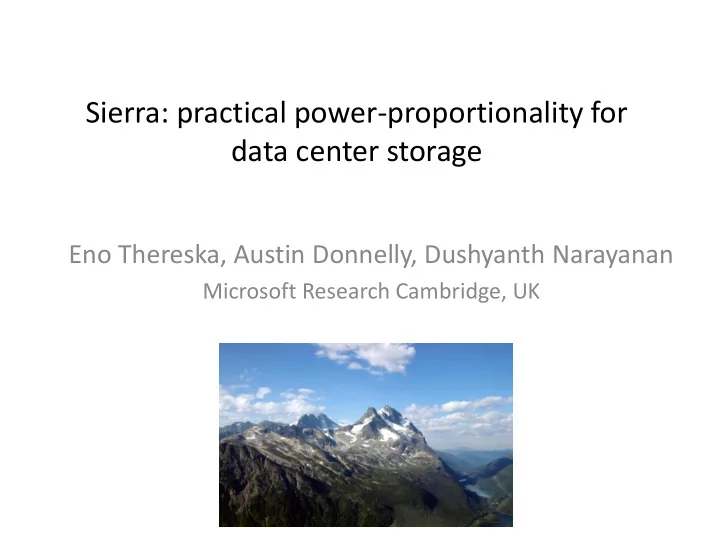

Sierra: practical power-proportionality for data center storage Eno Thereska, Austin Donnelly, Dushyanth Narayanan Microsoft Research Cambridge, UK
Our workloads have peaks and troughs 100% 100% 80% 80% 60% 60% 40% 40% 20% 20% Hotmail Messenger 0% 0% Servers not fully utilized, provisioned for peak Zero-load server draws ~60% of power of fully loaded server!
Goal: power-proportional data center power 0 load • Hardware is not power proportional – CPUs have DVS, but other components don’t • Power-proportionality in software – Turn off servers, rebalance CPU and I/O load
Storage is the elephant in the room CPU & network state can be migrated – Computation state: VM migration – Network: Chen et al. [NSDI’08] Storage state can not be migrated – Terabytes per server, petabytes per DC – Diurnal patterns migrate at least twice a day! • Turn servers off, but keep data available? – and consistent, and fault-tolerant
Context: Azure-like system NTFS as file system Metadata Object striped into chunks Service Chunk location and namespace Fixed-size (e.g., 64MB) chunks replicated (MDS) Highly available (replicated) Scalable & lightweight Primary-based concurrency control Not on data path Allow updates in place object-based read(chunk ID, offset, size...) read(), write(), create(), delete() write(chunk ID, offset, size, data...) Client library Chunk servers: CPU & storage co-located
Challenges • Availability, (strong) consistency • Recovery from transient failures • Fast rebuild after permanent failure • Good performance • Gear up/down without losing any of these
Sierra: storage subsystem with “gears” • Gear level g g replicas available – 0 ≤ g ≤ r = 3 – (r-g)/r of the servers are turned off – Gear level chosen based on load – At coarse time scale (hours)
Sierra in a nutshell • Exploit R-way replication for read availability • Careful layout to maximize #servers in standby • Distributed virtual log for write availability & read/write consistency • Good power savings – Hotmail: 23% - 50%
Outline • Motivation • Design • Evaluation • Future work and conclusion
Sierra design features • Power-aware layout • Distributed virtual log • Load prediction and gear scheduling policies
Power-aware layout replica group 1 O1 O1 O1 gear group 1 O2 gear group 2 O2 O3 replica group 2 O3 O4 O4 O4 Naïve random Naïve grouped Sierra Power-down r - g N(r – g)/r N(r – g)/r Rebuild ||ism N 1 N/r
Rack and switch layout 1 1 1 1 1 2 3 1 ... ... 2 2 2 2 2 3 1 2 ... ... 3 3 3 3 3 1 2 3 ... ... 1 1 1 1 1 2 3 1 ... ... ... ... Rack - aligned Rotated • Rack-aligned switch off entire racks • Rotated better thermal balance
What about write availability? • Distributed virtual log (DVL) write (C) write (C) S S S S P P L L L L L L offloading mode (low gear) reclaim mode (highest gear)
Distributed virtual log • Builds on past work [FAST’08,OSDI’08 ] • Evolved as a distributed system component – Available, consistent, recoverable, fault-tolerant – Location-aware (network locality , fault domains) – “Pick r closest loggers that are uncorrelated” • All data eventually reclaimed – Versioned store is for short-term use
Rack and switch layout C C C C C C C L ... ... L L L L C C C C C C C L ... ... L L L L C C C C C C C L ... ... L L L L C C C C C C C L ... ... L L L L ... ... Dedicated Co-located • Dedicated loggers avoid contention • Co-located loggers better multiplexing
Handling new failure modes • Failure detected using heartbeats • On chunkserver failure during low-gear – MDS wakes up all peers, migrate primaries – In g=1 there is short unavailability ~ O(time to wake up) – Tradeoff between power savings and availability using g=2 • Logger failures – Wake up servers, reclaim data • Failures from powering off servers – Power off few times a day – Rotate gearing
Load prediction and gear scheduling • Use past to predict future (very simple) – History in 1-hour buckets predict for next day – Schedule gear changes (at most once per hour) – Load metric considers rand/seq reads/writes • A hybrid predictive + reactive approach is likely to be superior for other workloads
Implementation status • User-level, event-based implementation in C • Chunk servers + MDS + client library = 11kLOC • DVL is 7.6 kLOC • 17 kLOC of support code (RPC libraries etc) • +NTFS (no changes) • MDS is not replicated yet
Summary of tradeoffs and limitations (see paper for interesting details) • New power-aware placement mechanism – Power savings vs. rebuild speed vs. load balancing • New service: distributed virtual log – Co-located with vs. dedicated chunk servers • Availability vs. power savings – 1 new failure case exposes this tradeoff • Spectrum of tradeoffs for gear scheduler – Predictive vs. reactive vs. hybrid
Outline • Motivation • Design • Evaluation • Future work and conclusion
Evaluation map • Analysis of 1-week large-scale load traces from Hotmail and Messenger – Can we predict load patterns? – What is the power savings potential? • 48-hour I/O request traces + hardware testbed – Does gear shifting hurt performance? – Power savings (current and upper bound)
Hotmail I/O traces • 8 Hotmail backend servers, 48 hours • 3-way replication • Block I/O traces • Data (msg files) accesses only • 1 MB chunk size (to fit trace)
Recommend
More recommend